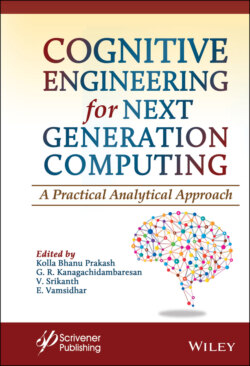Читать книгу Cognitive Engineering for Next Generation Computing - Группа авторов - Страница 48
1.12 Developing a Cognitive Computing Application
ОглавлениеCognitive computing is evolving at a good pace and in the next decade, a large number of applications can be built using this technology.
The organizations of different sectors are in the premature stages in developing the cognitive applications; its applications are from healthcare to production industries to governments, making a decision using the huge variety and volumes of data. There are some issues to be noted in the process of building the application [11].
1 A good decision can be taken if large volumes of data can be analyzed
2 There will be a change in decisions dynamically with the frequently varying data, obtaining data from the latest sources and also from the other forms of data
3 There should be a transfer of knowledge by the domain experts to the junior trainees through the training and mentoring process.
4 In the process of decision making a large amount of data is analyzed, several options and solutions to a problem are obtained.
To develop the cognitive application the first step is to define the objective, which requires understanding the types of problems the application can solve. It also has to consider the different types of users using the application. The most important thing is that it also has to take care of the types of issues the user is interested in and also what they are looking for and need to know. The next step is to define the domain, it is important because we need to identify and also assess the different data sources that match to build the application. Defining the domain helps to identify the subject experts.
In training the cognitive application the domain helps in identifying the subject experts that will be useful in training the cognitive application. Table 1.2 gives the examples of the Cognitive application domains.
Characterizing Questions and Exploring Insights
The cognitive applications that are developed in the early stages for customer engagement can be divided into two types:
1 Discovery and Exploration
2 Using sophisticated question and response mechanisms to
3 respond to inquiries as part of continuous exchange with the client.
The cognitive framework can build a relationship between questions, answers, and information to enable the client to better grasp the topic at a more profound level. The inquiries clients will pose can be set in two general classifications (Table 1.3):
1 Question–Response pairs: The responses to the inquiries can be unearthed in an information resource. There might be clashing responses inside the information resources, and the framework will break down the choices to furnish various reactions with related certainty levels.
2 Anticipatory analytics: The client takes part in an exchange with the cognitive application. The client may pose a few inquiries however not all the inquiries. The subjective application will utilize prescient models to envision the client’s next inquiry or arrangement of inquiries.
Table 1.2 Examples of cognitive application domains [11].
| S. no. | Domain | Data requirements to be selected | Subject experts |
|---|---|---|---|
| 1 | Medical | Electronic medical health records, International classification of diseases (ICD) Codes, Research journals | Experienced specialists, doctors, and specialists. |
| 2 | Airplane Manufacturing and Maintenance | List of complete parts, spare parts inventory and maintenance records of each plane | Skilled and qualified technicians, preservation staff, and trained and experienced pilots. These personsare capable of anticipating the failures and fix them |
| 3 | Trade | Client and product information | Skilled and qualified Salespersons |
Table 1.3 Question–response pairs for different types of users.
| S. no. | Question | Answer |
|---|---|---|
| 1 | Health Consumer: What Did You Say about a morcellator | A morcellator is a tool that consists of a spinning blade that is utilized to destroy a fibroid through an opening on a female’s stomach. The power and speed of the tool may make cell particles from the fibroid become scattered in the stomach. |
| 2 | Gynecologist: What are the consequences and advantages of utilizing a morcellator for careful treatment of fibroids? | Consequences incorporate likely spread of an occult uterine sarcoma. Advantages incorporate little incisions for the patient, lowblood loss, and faster healing and recovery. |
Along with the things we discussed above the following requirements are also needed to build the application
Creating and Refining the Corpora
Preparing the Data
Ingesting the Data
Refining and Expanding the Corpora
Governance of Data
Training and Testing
To understand the way to build a cognitive application here we discuss with the health care application.
